Applications and Theory of Polymerase Chain Reaction in Biology
VerifiedAdded on 2020/07/23
|6
|2052
|72
Report
AI Summary
This report provides a comprehensive overview of the Polymerase Chain Reaction (PCR) technique, detailing its mechanism, components, and stages. The report elucidates the three main stages: denaturing, annealing, and extending, which are crucial for DNA amplification. It discusses the practical applications of PCR, including forensic analysis, cloning, and medical research. The report also compares PCR with gene cloning, highlighting the advantages and limitations of each method. Furthermore, it outlines the lab testing process for determining the presence of bacterial DNA using PCR, along with a discussion on PCR's limitations, such as potential for errors and multiplexing issues. The report concludes by emphasizing the significance of PCR in modern molecular biology and its various practical applications.
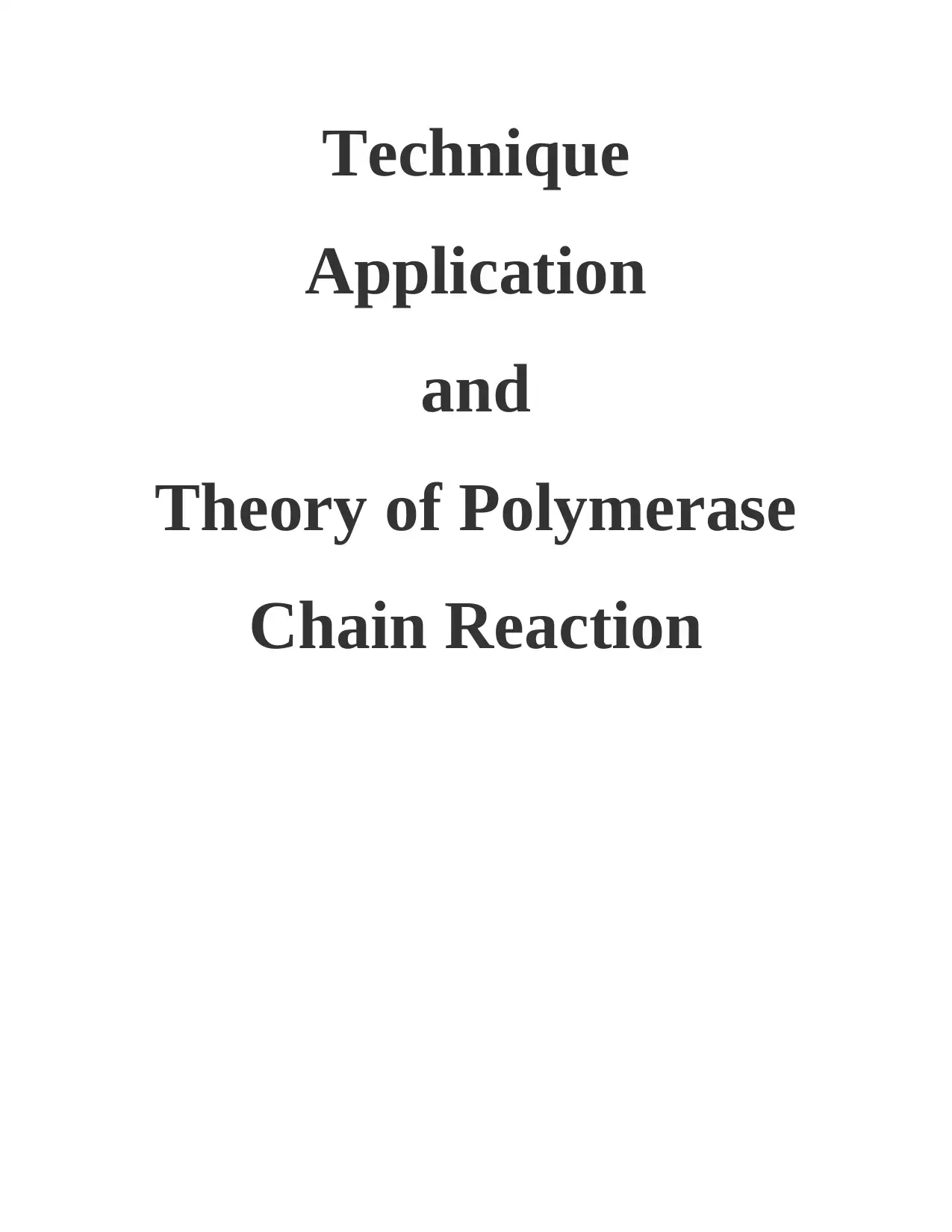
Technique
Application
and
Theory of Polymerase
Chain Reaction
Application
and
Theory of Polymerase
Chain Reaction
Paraphrase This Document
Need a fresh take? Get an instant paraphrase of this document with our AI Paraphraser
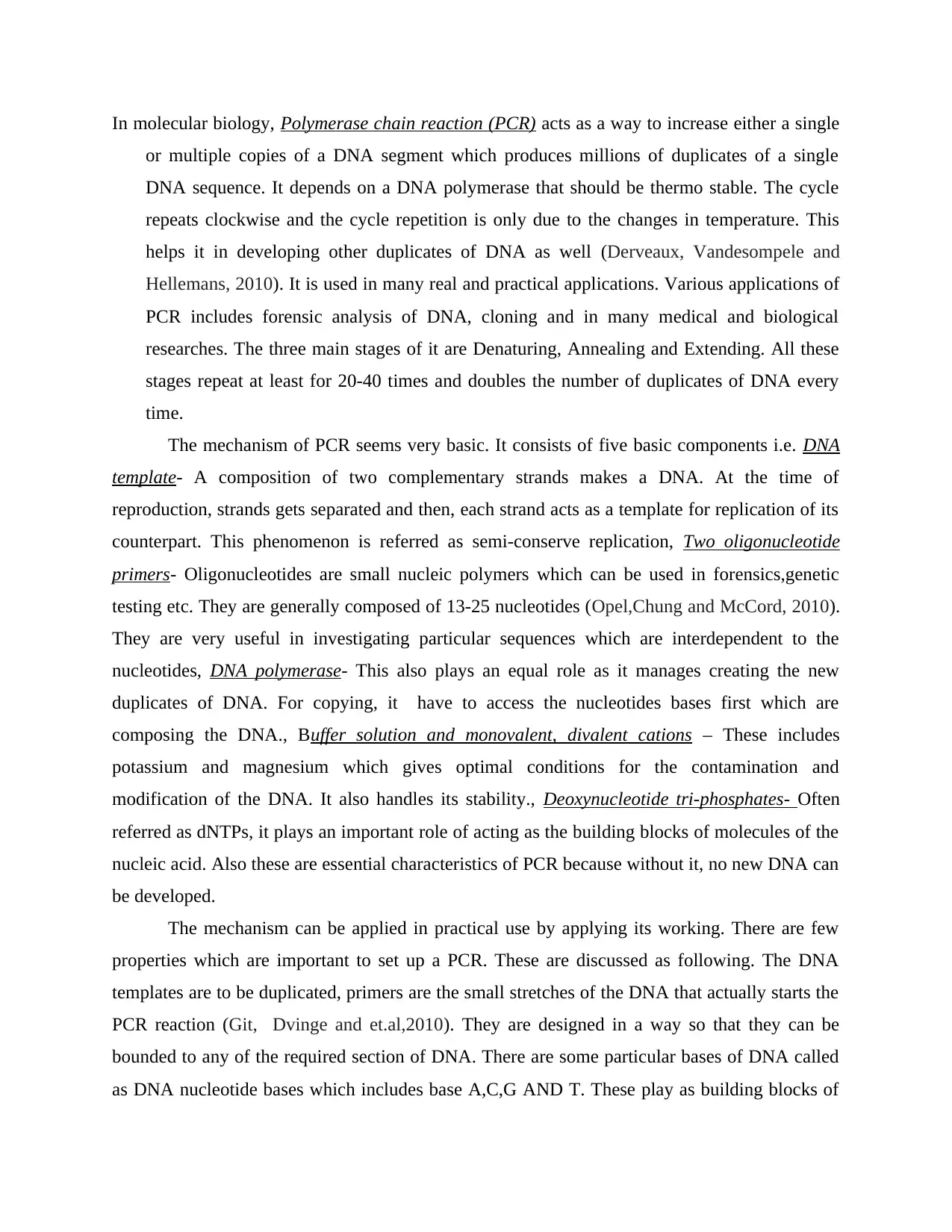
In molecular biology, Polymerase chain reaction (PCR) acts as a way to increase either a single
or multiple copies of a DNA segment which produces millions of duplicates of a single
DNA sequence. It depends on a DNA polymerase that should be thermo stable. The cycle
repeats clockwise and the cycle repetition is only due to the changes in temperature. This
helps it in developing other duplicates of DNA as well (Derveaux, Vandesompele and
Hellemans, 2010). It is used in many real and practical applications. Various applications of
PCR includes forensic analysis of DNA, cloning and in many medical and biological
researches. The three main stages of it are Denaturing, Annealing and Extending. All these
stages repeat at least for 20-40 times and doubles the number of duplicates of DNA every
time.
The mechanism of PCR seems very basic. It consists of five basic components i.e. DNA
template- A composition of two complementary strands makes a DNA. At the time of
reproduction, strands gets separated and then, each strand acts as a template for replication of its
counterpart. This phenomenon is referred as semi-conserve replication, Two oligonucleotide
primers- Oligonucleotides are small nucleic polymers which can be used in forensics,genetic
testing etc. They are generally composed of 13-25 nucleotides (Opel,Chung and McCord, 2010).
They are very useful in investigating particular sequences which are interdependent to the
nucleotides, DNA polymerase- This also plays an equal role as it manages creating the new
duplicates of DNA. For copying, it have to access the nucleotides bases first which are
composing the DNA., Buffer solution and monovalent, divalent cations – These includes
potassium and magnesium which gives optimal conditions for the contamination and
modification of the DNA. It also handles its stability., Deoxynucleotide tri-phosphates- Often
referred as dNTPs, it plays an important role of acting as the building blocks of molecules of the
nucleic acid. Also these are essential characteristics of PCR because without it, no new DNA can
be developed.
The mechanism can be applied in practical use by applying its working. There are few
properties which are important to set up a PCR. These are discussed as following. The DNA
templates are to be duplicated, primers are the small stretches of the DNA that actually starts the
PCR reaction (Git, Dvinge and et.al,2010). They are designed in a way so that they can be
bounded to any of the required section of DNA. There are some particular bases of DNA called
as DNA nucleotide bases which includes base A,C,G AND T. These play as building blocks of
or multiple copies of a DNA segment which produces millions of duplicates of a single
DNA sequence. It depends on a DNA polymerase that should be thermo stable. The cycle
repeats clockwise and the cycle repetition is only due to the changes in temperature. This
helps it in developing other duplicates of DNA as well (Derveaux, Vandesompele and
Hellemans, 2010). It is used in many real and practical applications. Various applications of
PCR includes forensic analysis of DNA, cloning and in many medical and biological
researches. The three main stages of it are Denaturing, Annealing and Extending. All these
stages repeat at least for 20-40 times and doubles the number of duplicates of DNA every
time.
The mechanism of PCR seems very basic. It consists of five basic components i.e. DNA
template- A composition of two complementary strands makes a DNA. At the time of
reproduction, strands gets separated and then, each strand acts as a template for replication of its
counterpart. This phenomenon is referred as semi-conserve replication, Two oligonucleotide
primers- Oligonucleotides are small nucleic polymers which can be used in forensics,genetic
testing etc. They are generally composed of 13-25 nucleotides (Opel,Chung and McCord, 2010).
They are very useful in investigating particular sequences which are interdependent to the
nucleotides, DNA polymerase- This also plays an equal role as it manages creating the new
duplicates of DNA. For copying, it have to access the nucleotides bases first which are
composing the DNA., Buffer solution and monovalent, divalent cations – These includes
potassium and magnesium which gives optimal conditions for the contamination and
modification of the DNA. It also handles its stability., Deoxynucleotide tri-phosphates- Often
referred as dNTPs, it plays an important role of acting as the building blocks of molecules of the
nucleic acid. Also these are essential characteristics of PCR because without it, no new DNA can
be developed.
The mechanism can be applied in practical use by applying its working. There are few
properties which are important to set up a PCR. These are discussed as following. The DNA
templates are to be duplicated, primers are the small stretches of the DNA that actually starts the
PCR reaction (Git, Dvinge and et.al,2010). They are designed in a way so that they can be
bounded to any of the required section of DNA. There are some particular bases of DNA called
as DNA nucleotide bases which includes base A,C,G AND T. These play as building blocks of
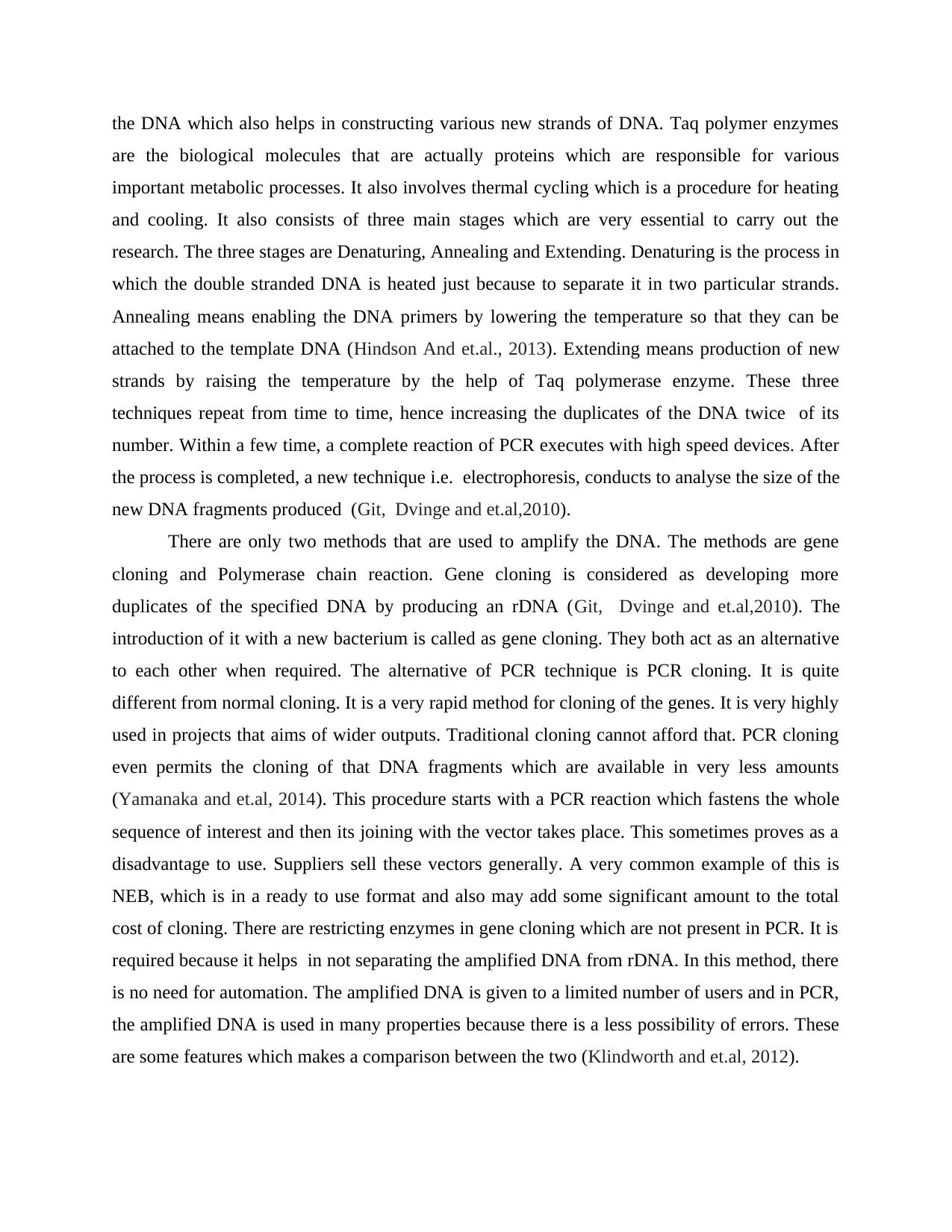
the DNA which also helps in constructing various new strands of DNA. Taq polymer enzymes
are the biological molecules that are actually proteins which are responsible for various
important metabolic processes. It also involves thermal cycling which is a procedure for heating
and cooling. It also consists of three main stages which are very essential to carry out the
research. The three stages are Denaturing, Annealing and Extending. Denaturing is the process in
which the double stranded DNA is heated just because to separate it in two particular strands.
Annealing means enabling the DNA primers by lowering the temperature so that they can be
attached to the template DNA (Hindson And et.al., 2013). Extending means production of new
strands by raising the temperature by the help of Taq polymerase enzyme. These three
techniques repeat from time to time, hence increasing the duplicates of the DNA twice of its
number. Within a few time, a complete reaction of PCR executes with high speed devices. After
the process is completed, a new technique i.e. electrophoresis, conducts to analyse the size of the
new DNA fragments produced (Git, Dvinge and et.al,2010).
There are only two methods that are used to amplify the DNA. The methods are gene
cloning and Polymerase chain reaction. Gene cloning is considered as developing more
duplicates of the specified DNA by producing an rDNA (Git, Dvinge and et.al,2010). The
introduction of it with a new bacterium is called as gene cloning. They both act as an alternative
to each other when required. The alternative of PCR technique is PCR cloning. It is quite
different from normal cloning. It is a very rapid method for cloning of the genes. It is very highly
used in projects that aims of wider outputs. Traditional cloning cannot afford that. PCR cloning
even permits the cloning of that DNA fragments which are available in very less amounts
(Yamanaka and et.al, 2014). This procedure starts with a PCR reaction which fastens the whole
sequence of interest and then its joining with the vector takes place. This sometimes proves as a
disadvantage to use. Suppliers sell these vectors generally. A very common example of this is
NEB, which is in a ready to use format and also may add some significant amount to the total
cost of cloning. There are restricting enzymes in gene cloning which are not present in PCR. It is
required because it helps in not separating the amplified DNA from rDNA. In this method, there
is no need for automation. The amplified DNA is given to a limited number of users and in PCR,
the amplified DNA is used in many properties because there is a less possibility of errors. These
are some features which makes a comparison between the two (Klindworth and et.al, 2012).
are the biological molecules that are actually proteins which are responsible for various
important metabolic processes. It also involves thermal cycling which is a procedure for heating
and cooling. It also consists of three main stages which are very essential to carry out the
research. The three stages are Denaturing, Annealing and Extending. Denaturing is the process in
which the double stranded DNA is heated just because to separate it in two particular strands.
Annealing means enabling the DNA primers by lowering the temperature so that they can be
attached to the template DNA (Hindson And et.al., 2013). Extending means production of new
strands by raising the temperature by the help of Taq polymerase enzyme. These three
techniques repeat from time to time, hence increasing the duplicates of the DNA twice of its
number. Within a few time, a complete reaction of PCR executes with high speed devices. After
the process is completed, a new technique i.e. electrophoresis, conducts to analyse the size of the
new DNA fragments produced (Git, Dvinge and et.al,2010).
There are only two methods that are used to amplify the DNA. The methods are gene
cloning and Polymerase chain reaction. Gene cloning is considered as developing more
duplicates of the specified DNA by producing an rDNA (Git, Dvinge and et.al,2010). The
introduction of it with a new bacterium is called as gene cloning. They both act as an alternative
to each other when required. The alternative of PCR technique is PCR cloning. It is quite
different from normal cloning. It is a very rapid method for cloning of the genes. It is very highly
used in projects that aims of wider outputs. Traditional cloning cannot afford that. PCR cloning
even permits the cloning of that DNA fragments which are available in very less amounts
(Yamanaka and et.al, 2014). This procedure starts with a PCR reaction which fastens the whole
sequence of interest and then its joining with the vector takes place. This sometimes proves as a
disadvantage to use. Suppliers sell these vectors generally. A very common example of this is
NEB, which is in a ready to use format and also may add some significant amount to the total
cost of cloning. There are restricting enzymes in gene cloning which are not present in PCR. It is
required because it helps in not separating the amplified DNA from rDNA. In this method, there
is no need for automation. The amplified DNA is given to a limited number of users and in PCR,
the amplified DNA is used in many properties because there is a less possibility of errors. These
are some features which makes a comparison between the two (Klindworth and et.al, 2012).
⊘ This is a preview!⊘
Do you want full access?
Subscribe today to unlock all pages.

Trusted by 1+ million students worldwide
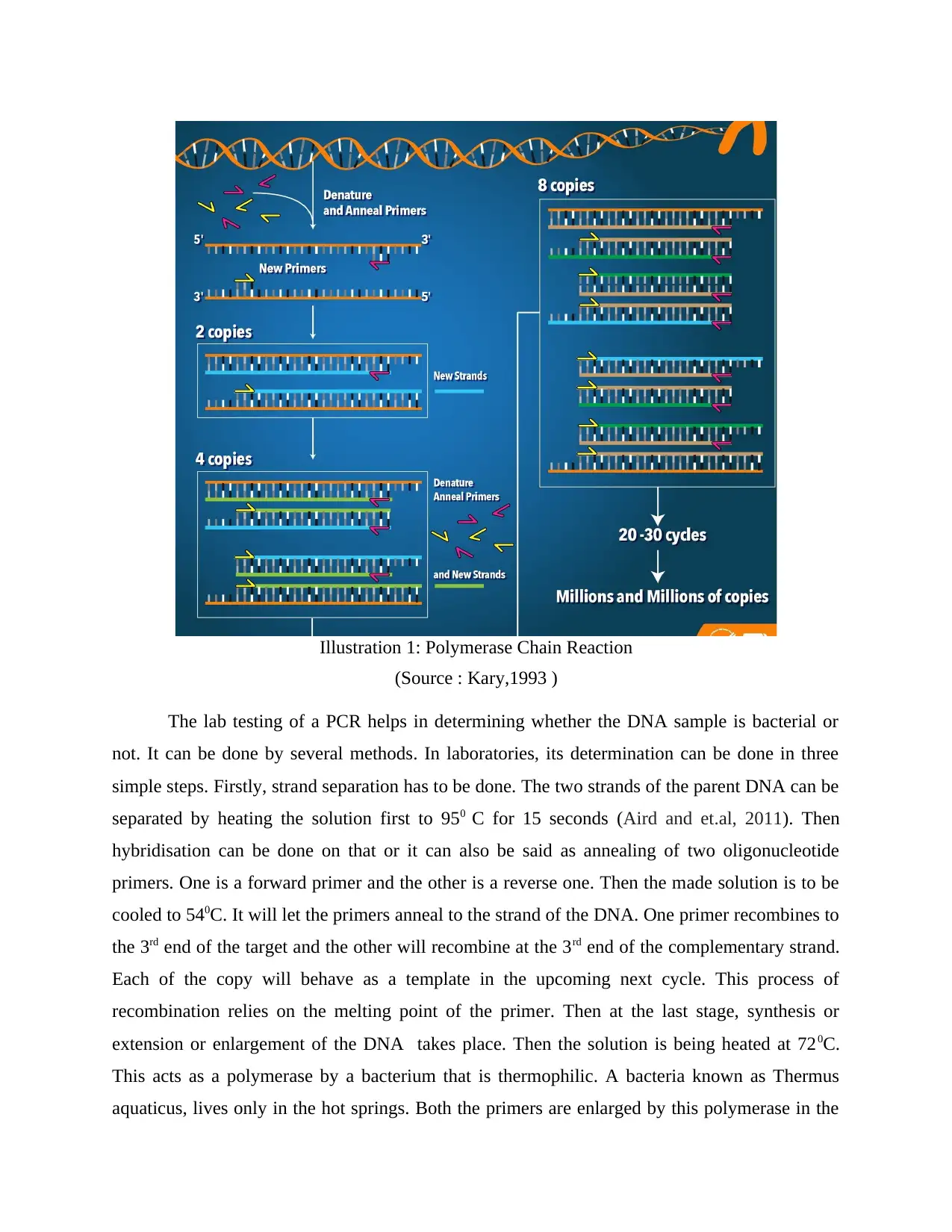
The lab testing of a PCR helps in determining whether the DNA sample is bacterial or
not. It can be done by several methods. In laboratories, its determination can be done in three
simple steps. Firstly, strand separation has to be done. The two strands of the parent DNA can be
separated by heating the solution first to 950 C for 15 seconds (Aird and et.al, 2011). Then
hybridisation can be done on that or it can also be said as annealing of two oligonucleotide
primers. One is a forward primer and the other is a reverse one. Then the made solution is to be
cooled to 540C. It will let the primers anneal to the strand of the DNA. One primer recombines to
the 3rd end of the target and the other will recombine at the 3rd end of the complementary strand.
Each of the copy will behave as a template in the upcoming next cycle. This process of
recombination relies on the melting point of the primer. Then at the last stage, synthesis or
extension or enlargement of the DNA takes place. Then the solution is being heated at 720C.
This acts as a polymerase by a bacterium that is thermophilic. A bacteria known as Thermus
aquaticus, lives only in the hot springs. Both the primers are enlarged by this polymerase in the
Illustration 1: Polymerase Chain Reaction
(Source : Kary,1993 )
not. It can be done by several methods. In laboratories, its determination can be done in three
simple steps. Firstly, strand separation has to be done. The two strands of the parent DNA can be
separated by heating the solution first to 950 C for 15 seconds (Aird and et.al, 2011). Then
hybridisation can be done on that or it can also be said as annealing of two oligonucleotide
primers. One is a forward primer and the other is a reverse one. Then the made solution is to be
cooled to 540C. It will let the primers anneal to the strand of the DNA. One primer recombines to
the 3rd end of the target and the other will recombine at the 3rd end of the complementary strand.
Each of the copy will behave as a template in the upcoming next cycle. This process of
recombination relies on the melting point of the primer. Then at the last stage, synthesis or
extension or enlargement of the DNA takes place. Then the solution is being heated at 720C.
This acts as a polymerase by a bacterium that is thermophilic. A bacteria known as Thermus
aquaticus, lives only in the hot springs. Both the primers are enlarged by this polymerase in the
Illustration 1: Polymerase Chain Reaction
(Source : Kary,1993 )
Paraphrase This Document
Need a fresh take? Get an instant paraphrase of this document with our AI Paraphraser
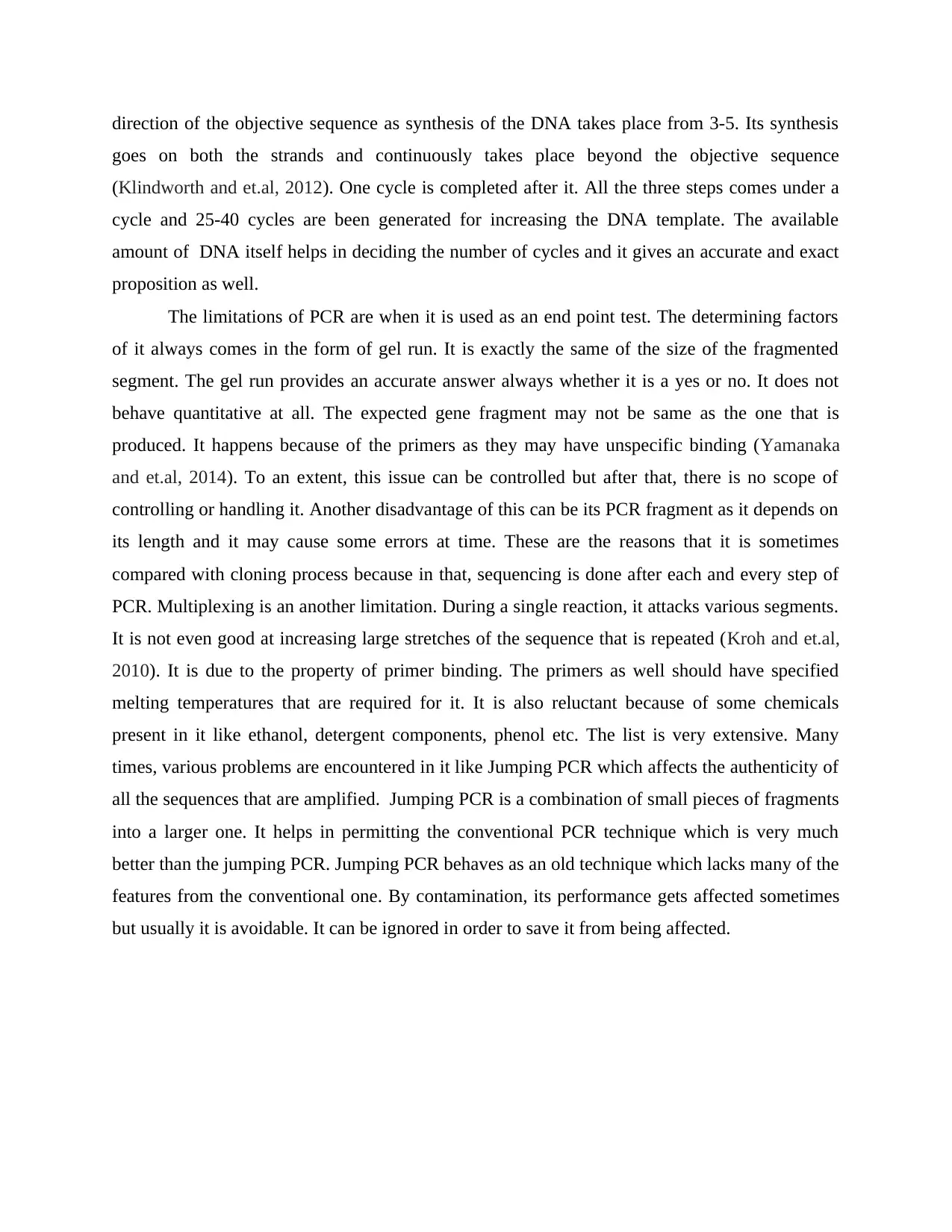
direction of the objective sequence as synthesis of the DNA takes place from 3-5. Its synthesis
goes on both the strands and continuously takes place beyond the objective sequence
(Klindworth and et.al, 2012). One cycle is completed after it. All the three steps comes under a
cycle and 25-40 cycles are been generated for increasing the DNA template. The available
amount of DNA itself helps in deciding the number of cycles and it gives an accurate and exact
proposition as well.
The limitations of PCR are when it is used as an end point test. The determining factors
of it always comes in the form of gel run. It is exactly the same of the size of the fragmented
segment. The gel run provides an accurate answer always whether it is a yes or no. It does not
behave quantitative at all. The expected gene fragment may not be same as the one that is
produced. It happens because of the primers as they may have unspecific binding (Yamanaka
and et.al, 2014). To an extent, this issue can be controlled but after that, there is no scope of
controlling or handling it. Another disadvantage of this can be its PCR fragment as it depends on
its length and it may cause some errors at time. These are the reasons that it is sometimes
compared with cloning process because in that, sequencing is done after each and every step of
PCR. Multiplexing is an another limitation. During a single reaction, it attacks various segments.
It is not even good at increasing large stretches of the sequence that is repeated (Kroh and et.al,
2010). It is due to the property of primer binding. The primers as well should have specified
melting temperatures that are required for it. It is also reluctant because of some chemicals
present in it like ethanol, detergent components, phenol etc. The list is very extensive. Many
times, various problems are encountered in it like Jumping PCR which affects the authenticity of
all the sequences that are amplified. Jumping PCR is a combination of small pieces of fragments
into a larger one. It helps in permitting the conventional PCR technique which is very much
better than the jumping PCR. Jumping PCR behaves as an old technique which lacks many of the
features from the conventional one. By contamination, its performance gets affected sometimes
but usually it is avoidable. It can be ignored in order to save it from being affected.
goes on both the strands and continuously takes place beyond the objective sequence
(Klindworth and et.al, 2012). One cycle is completed after it. All the three steps comes under a
cycle and 25-40 cycles are been generated for increasing the DNA template. The available
amount of DNA itself helps in deciding the number of cycles and it gives an accurate and exact
proposition as well.
The limitations of PCR are when it is used as an end point test. The determining factors
of it always comes in the form of gel run. It is exactly the same of the size of the fragmented
segment. The gel run provides an accurate answer always whether it is a yes or no. It does not
behave quantitative at all. The expected gene fragment may not be same as the one that is
produced. It happens because of the primers as they may have unspecific binding (Yamanaka
and et.al, 2014). To an extent, this issue can be controlled but after that, there is no scope of
controlling or handling it. Another disadvantage of this can be its PCR fragment as it depends on
its length and it may cause some errors at time. These are the reasons that it is sometimes
compared with cloning process because in that, sequencing is done after each and every step of
PCR. Multiplexing is an another limitation. During a single reaction, it attacks various segments.
It is not even good at increasing large stretches of the sequence that is repeated (Kroh and et.al,
2010). It is due to the property of primer binding. The primers as well should have specified
melting temperatures that are required for it. It is also reluctant because of some chemicals
present in it like ethanol, detergent components, phenol etc. The list is very extensive. Many
times, various problems are encountered in it like Jumping PCR which affects the authenticity of
all the sequences that are amplified. Jumping PCR is a combination of small pieces of fragments
into a larger one. It helps in permitting the conventional PCR technique which is very much
better than the jumping PCR. Jumping PCR behaves as an old technique which lacks many of the
features from the conventional one. By contamination, its performance gets affected sometimes
but usually it is avoidable. It can be ignored in order to save it from being affected.
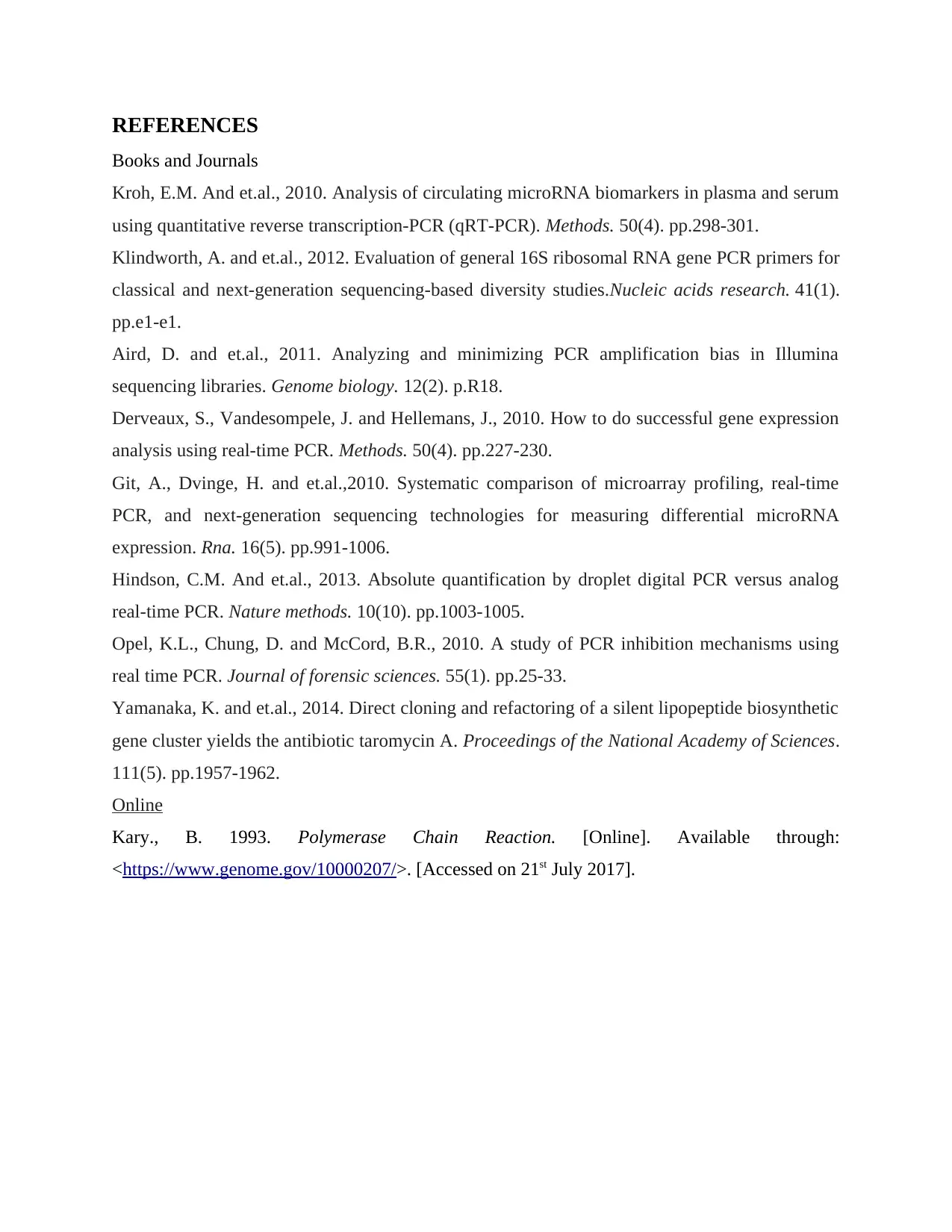
REFERENCES
Books and Journals
Kroh, E.M. And et.al., 2010. Analysis of circulating microRNA biomarkers in plasma and serum
using quantitative reverse transcription-PCR (qRT-PCR). Methods. 50(4). pp.298-301.
Klindworth, A. and et.al., 2012. Evaluation of general 16S ribosomal RNA gene PCR primers for
classical and next-generation sequencing-based diversity studies.Nucleic acids research. 41(1).
pp.e1-e1.
Aird, D. and et.al., 2011. Analyzing and minimizing PCR amplification bias in Illumina
sequencing libraries. Genome biology. 12(2). p.R18.
Derveaux, S., Vandesompele, J. and Hellemans, J., 2010. How to do successful gene expression
analysis using real-time PCR. Methods. 50(4). pp.227-230.
Git, A., Dvinge, H. and et.al.,2010. Systematic comparison of microarray profiling, real-time
PCR, and next-generation sequencing technologies for measuring differential microRNA
expression. Rna. 16(5). pp.991-1006.
Hindson, C.M. And et.al., 2013. Absolute quantification by droplet digital PCR versus analog
real-time PCR. Nature methods. 10(10). pp.1003-1005.
Opel, K.L., Chung, D. and McCord, B.R., 2010. A study of PCR inhibition mechanisms using
real time PCR. Journal of forensic sciences. 55(1). pp.25-33.
Yamanaka, K. and et.al., 2014. Direct cloning and refactoring of a silent lipopeptide biosynthetic
gene cluster yields the antibiotic taromycin A. Proceedings of the National Academy of Sciences.
111(5). pp.1957-1962.
Online
Kary., B. 1993. Polymerase Chain Reaction. [Online]. Available through:
<https://www.genome.gov/10000207/>. [Accessed on 21st July 2017].
Books and Journals
Kroh, E.M. And et.al., 2010. Analysis of circulating microRNA biomarkers in plasma and serum
using quantitative reverse transcription-PCR (qRT-PCR). Methods. 50(4). pp.298-301.
Klindworth, A. and et.al., 2012. Evaluation of general 16S ribosomal RNA gene PCR primers for
classical and next-generation sequencing-based diversity studies.Nucleic acids research. 41(1).
pp.e1-e1.
Aird, D. and et.al., 2011. Analyzing and minimizing PCR amplification bias in Illumina
sequencing libraries. Genome biology. 12(2). p.R18.
Derveaux, S., Vandesompele, J. and Hellemans, J., 2010. How to do successful gene expression
analysis using real-time PCR. Methods. 50(4). pp.227-230.
Git, A., Dvinge, H. and et.al.,2010. Systematic comparison of microarray profiling, real-time
PCR, and next-generation sequencing technologies for measuring differential microRNA
expression. Rna. 16(5). pp.991-1006.
Hindson, C.M. And et.al., 2013. Absolute quantification by droplet digital PCR versus analog
real-time PCR. Nature methods. 10(10). pp.1003-1005.
Opel, K.L., Chung, D. and McCord, B.R., 2010. A study of PCR inhibition mechanisms using
real time PCR. Journal of forensic sciences. 55(1). pp.25-33.
Yamanaka, K. and et.al., 2014. Direct cloning and refactoring of a silent lipopeptide biosynthetic
gene cluster yields the antibiotic taromycin A. Proceedings of the National Academy of Sciences.
111(5). pp.1957-1962.
Online
Kary., B. 1993. Polymerase Chain Reaction. [Online]. Available through:
<https://www.genome.gov/10000207/>. [Accessed on 21st July 2017].
⊘ This is a preview!⊘
Do you want full access?
Subscribe today to unlock all pages.

Trusted by 1+ million students worldwide
1 out of 6
Related Documents
Your All-in-One AI-Powered Toolkit for Academic Success.
+13062052269
info@desklib.com
Available 24*7 on WhatsApp / Email
![[object Object]](/_next/static/media/star-bottom.7253800d.svg)
Unlock your academic potential
Copyright © 2020–2025 A2Z Services. All Rights Reserved. Developed and managed by ZUCOL.





